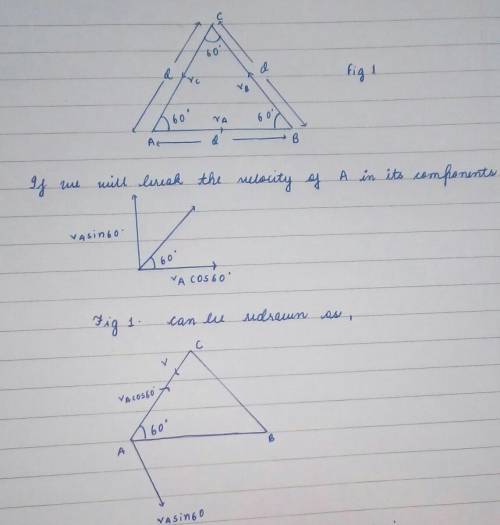
Physics, 13.02.2022 05:50 mzbugsbunny3029
 Three particles A, B and C are situated at the vertices of an equilateral triangle ABC of side d at time t = 0. Each of the particles moves with constant speed v. A always has its velocity along AB, B along BC and C along CA. At what time will the particles meet each other ?
Three particles A, B and C are situated at the vertices of an equilateral triangle ABC of side d at time t = 0. Each of the particles moves with constant speed v. A always has its velocity along AB, B along BC and C along CA. At what time will the particles meet each other ?
- Don't want spam or copied answers
- Don't be greedy for points
- Best answer will be awarded with brainliest.

Answers: 1


Another question on Physics

Physics, 22.06.2019 08:40
An isolated conducting spherical shell carries a positive charge. part a which statement (or statements) about the electric field and the electric potential inside and outside the spherical shell is correct? which statement (or statements) about the electric field and the electric potential inside and outside the spherical shell is correct? electric potential inside the shell is constant and outside the shell is changing as 1/r2 both the electric potential and the electric field does change with r inside and outside the spherical shell electric potential inside and outside the shell is constant, but not zero electric potential inside the shell is constant and outside the shell is equal to zero electric field inside and outside the shell is constant (does not change with the position r), but is not equal to zero electric field inside and outside the shell is changing as 1/r (where r is the distance from the center of the sphere) electric field inside is equal to zero and outside the shell is constant, but not zero electric potential inside the shell is constant and outside the shell is changing as 1/r electric field inside and outside the shell is changing as 1/r2 electric field inside is equal to zero and outside the shell is changing as 1/r2 electric field inside and outside the shell is zero electric field inside is constant and outside the shell is changing as 1/r
Answers: 3

Physics, 22.06.2019 13:10
The bar of prob. 5/82 is repeated here. the ends of the 0.4-m bar remain in contact with their re- spective support surfaces. end b has a velocity of 0.5 m/s and an acceleration of 0.3 m/s2 in the di- rections shown. determine the angular accelera- tion of the bar and the acceleration of end a.
Answers: 3

Physics, 22.06.2019 16:40
On your wedding day your lover gives you a gold ring of mass 3.67 g. 48 years later its mass is 3.44 g. on the average how many atoms were abrated from the ring during each second of your marriage? the atomic mass of gold is 197 u. don't enter units
Answers: 1

Physics, 22.06.2019 16:50
Abird flies directly overhead from where you stand at an altitude of 300.0 m and at a speed horizontal to the ground of 20.0 m/s. the bird has a mass of 2.0 kg. the radius vector to the bird makes an angle \thetaθ with respect to the ground. the radius vector to the bird and its momentum vector lie in the xyxy-plane. what is the bird’s angular momentum about the point where you are standing?
Answers: 2
You know the right answer?
Three particles A, B and C are situated at the vertices of an equilateral triangle ABC of side d a...
Questions

Mathematics, 23.03.2021 03:50

Social Studies, 23.03.2021 03:50



Mathematics, 23.03.2021 03:50

Mathematics, 23.03.2021 03:50

Mathematics, 23.03.2021 03:50





History, 23.03.2021 03:50


Mathematics, 23.03.2021 03:50

Social Studies, 23.03.2021 03:50



Mathematics, 23.03.2021 03:50

Spanish, 23.03.2021 03:50

Mathematics, 23.03.2021 03:50



 coincides on side AC and is directed from A to C . Along CA, the velocity of particle C is directed . So both are in opposite directions.
coincides on side AC and is directed from A to C . Along CA, the velocity of particle C is directed . So both are in opposite directions. 










